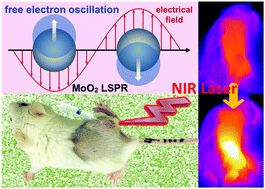当前位置:
X-MOL 学术
›
J. Mater. Chem. B
›
论文详情
Our official English website, www.x-mol.net, welcomes your
feedback! (Note: you will need to create a separate account there.)
Metallic oxide nanocrystals with near-infrared plasmon resonance for efficient, stable and biocompatible photothermal cancer therapy
Journal of Materials Chemistry B ( IF 6.1 ) Pub Date : 2017-08-15 00:00:00 , DOI: 10.1039/c7tb01832k Kang Dou 1, 2, 3, 4, 5 , Wenwen Zhu 6, 7, 8, 9 , Yousheng Zou 1, 2, 3, 4, 5 , Yu Gu 1, 2, 3, 4, 5 , Jubin Li 1, 2, 3, 4, 5 , Shengli Zhang 1, 2, 3, 4, 5 , Zhuang Liu 6, 7, 8, 9 , Haibo Zeng 1, 2, 3, 4, 5
Journal of Materials Chemistry B ( IF 6.1 ) Pub Date : 2017-08-15 00:00:00 , DOI: 10.1039/c7tb01832k Kang Dou 1, 2, 3, 4, 5 , Wenwen Zhu 6, 7, 8, 9 , Yousheng Zou 1, 2, 3, 4, 5 , Yu Gu 1, 2, 3, 4, 5 , Jubin Li 1, 2, 3, 4, 5 , Shengli Zhang 1, 2, 3, 4, 5 , Zhuang Liu 6, 7, 8, 9 , Haibo Zeng 1, 2, 3, 4, 5
Affiliation

|
Photothermal therapy is regarded as one of the most promising cancer treatment technologies due to its negligible side effects and fast operation. However, its therapeutic efficacy is still limited by the lack of cost-effective photostable and biocompatible therapeutic agents with efficient light absorption in the biological window. Here, taking MoO2 as an example, we propose oxide nanocrystals (NCs), with both a metallic electronic structure and near-infrared (NIR) plasmon resonance, for efficient, stable and biocompatible photothermal cancer therapy. Monoclinic MoO2 NCs with good crystallinity were fabricated through the combination of laser ablation in liquid and solvothermal synthesis. The as-synthesized NCs showed intensive local surface plasmon resonance (LSPR) absorption at 800–1000 nm, the NIR biological window, due to their metallic electronic structure and oxide dielectric function. This unique NIR LSPR characteristic leads to excellent photothermal performance, i.e., the maximum temperature elevation was found to be up to 37.5 °C with a MoO2 NC concentration of 0.05 mg mL−1 under 808 nm laser irradiation. Moreover, MoO2 solution is highly photostable, as it exhibits stable irradiation-induced temperature elevation of about 14.3 °C even after four temperature elevation cycles. As a photothermal therapy agent against 4T1 cancer cells, MoO2 NCs exhibit not only good biocompatibility, but also excellent tumor inhibition effects. The highest inhibition rate was up to 80.45%, and the average tumor volume was 2.73 times smaller than normal growth 14 days after the treatment. The results prove that MoO2 NCs exhibiting NIR LSPR can act as an effective agent for photothermal cancer therapy with great photostability and biocompatibility.
中文翻译:

具有近红外等离子体共振的金属氧化物纳米晶体,可进行有效,稳定和生物相容的光热癌症治疗
由于光热疗法的副作用可忽略不计且操作迅速,因此被认为是最有前途的癌症治疗技术之一。然而,由于缺乏在生物窗口中具有有效光吸收的经济有效的光稳定和生物相容性治疗剂,其治疗功效仍然受到限制。在这里,以MoO 2为例,我们提出了具有金属电子结构和近红外(NIR)等离子体共振的氧化物纳米晶体(NCs),以进行有效,稳定和生物相容的光热癌症治疗。单斜MoO 2通过液相和溶剂热合成中激光烧蚀的结合,制备了具有良好结晶度的NC。合成后的NC由于其金属电子结构和氧化物介电功能,在800-1000 nm(NIR生物窗口)处显示出强烈的局部表面等离子体共振(LSPR)吸收。这种独特的NIR LSPR特性导致出色的光热性能,即在808 nm激光照射下,MoO 2 NC浓度为0.05 mg mL -1时,最高温度升高至37.5°C 。此外,MoO 2该溶液具有很高的光稳定性,因为即使经过四个温度升高循环,它仍能稳定地引起约14.3°C的辐射诱导温度升高。作为针对4T1癌细胞的光热治疗剂,MoO 2 NCs不仅具有良好的生物相容性,而且还具有出色的抑瘤作用。治疗后14天,最高抑制率高达80.45%,平均肿瘤体积比正常生长小2.73倍。结果证明,具有NIR LSPR的MoO 2 NCs具有良好的光稳定性和生物相容性,可以作为光热癌治疗的有效药物。
更新日期:2017-09-13
中文翻译:

具有近红外等离子体共振的金属氧化物纳米晶体,可进行有效,稳定和生物相容的光热癌症治疗
由于光热疗法的副作用可忽略不计且操作迅速,因此被认为是最有前途的癌症治疗技术之一。然而,由于缺乏在生物窗口中具有有效光吸收的经济有效的光稳定和生物相容性治疗剂,其治疗功效仍然受到限制。在这里,以MoO 2为例,我们提出了具有金属电子结构和近红外(NIR)等离子体共振的氧化物纳米晶体(NCs),以进行有效,稳定和生物相容的光热癌症治疗。单斜MoO 2通过液相和溶剂热合成中激光烧蚀的结合,制备了具有良好结晶度的NC。合成后的NC由于其金属电子结构和氧化物介电功能,在800-1000 nm(NIR生物窗口)处显示出强烈的局部表面等离子体共振(LSPR)吸收。这种独特的NIR LSPR特性导致出色的光热性能,即在808 nm激光照射下,MoO 2 NC浓度为0.05 mg mL -1时,最高温度升高至37.5°C 。此外,MoO 2该溶液具有很高的光稳定性,因为即使经过四个温度升高循环,它仍能稳定地引起约14.3°C的辐射诱导温度升高。作为针对4T1癌细胞的光热治疗剂,MoO 2 NCs不仅具有良好的生物相容性,而且还具有出色的抑瘤作用。治疗后14天,最高抑制率高达80.45%,平均肿瘤体积比正常生长小2.73倍。结果证明,具有NIR LSPR的MoO 2 NCs具有良好的光稳定性和生物相容性,可以作为光热癌治疗的有效药物。











































 京公网安备 11010802027423号
京公网安备 11010802027423号